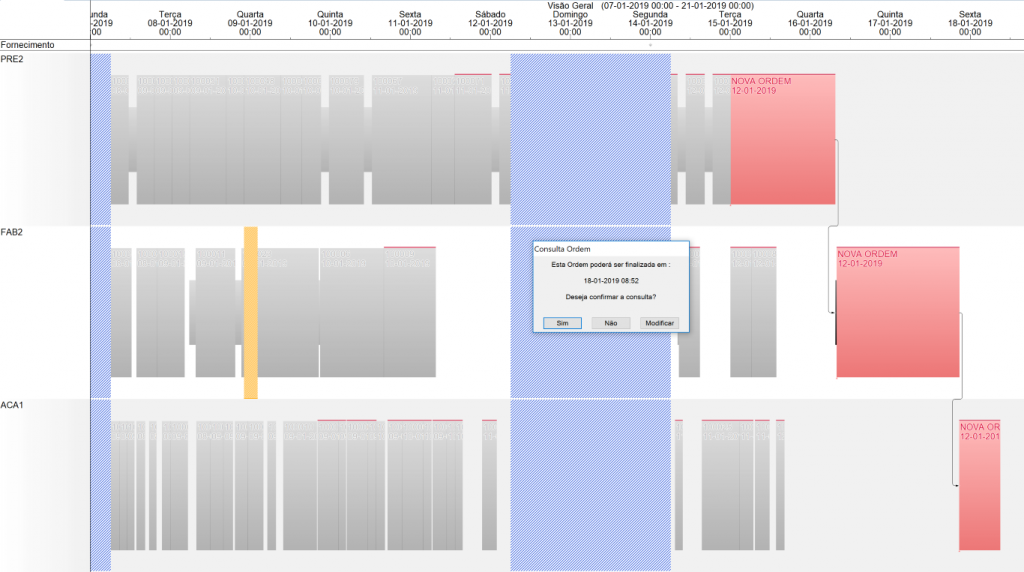The Delivery DatemesChallenge

PRODUCTION AND DELIVERY DATES When working with industry, we see many production system orientations: make-to-stock, make-to-order, assembly-to-order, engineering-to-order, as well as hybrid systems that mix these different orientations. It is very common for some industries to choose products with high demand and long life cycles to be produced for stock in order to reduce lead times mes replenishment to the market and gain production efficiency, while customized products, which do not have much continuous demand or have a very short life cycle (as in the fashion industry), are produced only to order. While the challenge of make-to-stock (MTS) is to produce in the right quantities to avoid obsolescence and high inventory costs, the challenge of make-to-order (MTO) is to deliver products quickly from the moment a customer places an order, without harming production efficiency and, perhaps even more importantly, without delaying delivery! To be perfectly clear, the fact is that we have two delivery dates: the date the customer wants to receive the product and the date the industry commits to delivering it. Often these dates are quite different from each other. There are cases where there is no choice and the customer will define the delivery date that the supplier must meet based on market requirements and standards. But there are still cases where there is a dialogue between the company to define a definitive delivery date. It is at this moment that PPC plays a crucial role in better customer service (or at least it should). To MES a delivery date that is feasible for production, ideally the PPC / PPC M area should be responsible for this, since it is the area capable of analyzing all production variables (current production volume, materials, available resources, shifts, maintenance, tools, etc.) to see when and how these orders can enter production. In many cases, we see company working with fixed lead mes for mes delivery dates, sometimes with standard values for each and every product. However, reality shows that each product has specific manufacturing routes and needs, which can mean that one product can be produced much faster than another, making it illogical for both to have the mes lead time. Therefore, it is recommended that the methods and processes engineering areas analyze and classify products appropriately according to the production effort of each one. It is not problematic to work with fixed lead mes per product family and, if the products are similar, ultimately, it is also not wrong to have a fixed lead time for all your products. This can be a very interesting facilitator for the sales area. However, the PPC needs to analyze these incoming production orders, validate their on-time delivery, and have contingency processes in place for delays. Whether it's an order arriving without a delivery date, which PPC mes define and pass on to the sales department to the client, or an order arriving with a delivery date, and PPC confirming whether or not it's possible to deliver on time, this department needs to do so in a way that aligns with the reality of the factory(ies). Otherwise, we're making a promise mes don't know if we can keep. And there's nothing worse for a company , besides product quality factors, than failing to meet delivery deadlines. PROMISE WHAT YOU CAN DELIVER . It's at times like these that technological support can provide the necessary backing to avoid unnecessary delays and disruptions. To have a good delivery date promise process, we need to have two things very well implemented and internalized by the industry areas: an agile communication and information process between the commercial and PPC areas mes PPC company 's commercial characteristics (1), as well as an accurate and reliable production scheduling system that can properly assess production variables (2).[caption id="attachment_2067" align="aligncenter" width="547"]

Feasible Delivery Date Query in Preactor APS Software[/caption]To establish this process from the first point raised, it's necessary to understand whether the market requires immediate responses to demands or whether it's possible to standardize a process with time windows to perform bulk order analysis. For the first case, a higher level of automation is required, as orders will arrive dispersed over time and require fast, individualized feedback. This allows PPC to be more focused on generating business rules so this systematic process can occur without the need for a team member to be available at all times to promise deadlines. For the second case, where one can work with one- or two-shift deadlines for information feedback, a process with greater involvement between departments and scheduled simulations can be created to generate delivery dates for all orders received within a time window. This allows, in cases where there isn't enough production capacity, or where the factory's schedule needs to be more extensively modified to meet a specific need, a highly aligned dialogue and consensus can occur between sales and PPC to make decisions. Regarding the second important point, regarding a reliable production scheduling system, it's essential to consider that our factory(s) have a finite capacity, and that this isn't decipherable solely with machine/person load analyses. Rather, we need a system capable of handling a wide range of variables, from the machinery available for production, the synchronization between production operations, to critical tooling, labor, or even physical space constraints. Otherwise, confirming an order by looking at a spreadsheet or flipping a coin is mes as effective. To learn more about these systems and how they work, learn more about Preactor APS and contact NEO ! [noptin-form id=2822]

